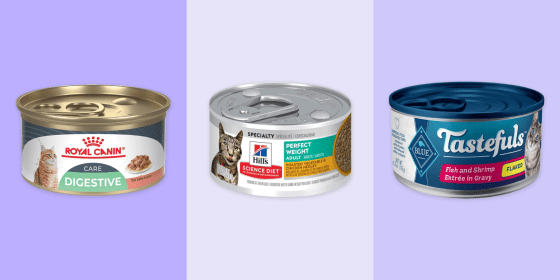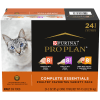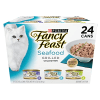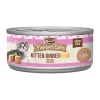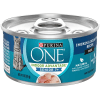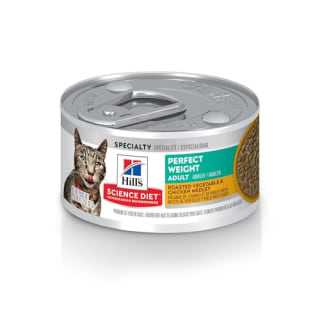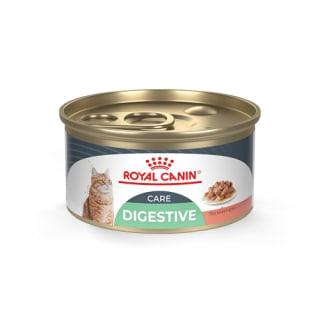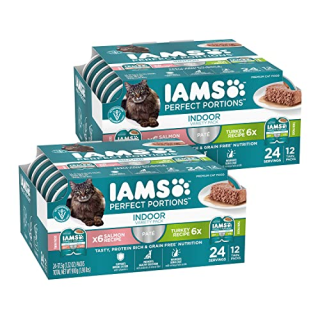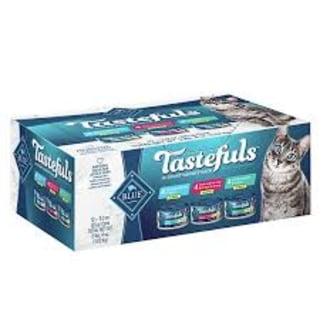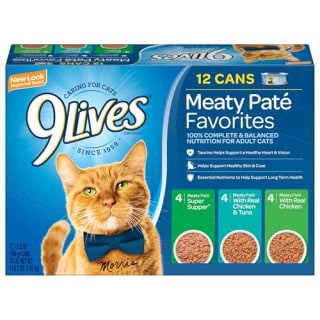Do you really need to feed your cat wet food? It’s a question many pet owners ask themselves, especially since the cans and packets tend to be pricier than a bag of dry kibble. But all the vets I spoke to unanimously agree: wet cat food is an essential part of a healthy, balanced diet, and since it has a soft, moisture texture, it helps felines stay hydrated, which is important for digestion, kidney function, circulation and more.
To help you find the best wet cat food for your pet, I spoke to veterinarians about what factors to consider while shopping and rounded up a handful of nutritious options. Vets also explain why you should stay away from raw cat food, and share tips for changing your kitty’s diet.
SKIP AHEAD The best wet cat food of 2025 | Why trust NBC Select?
Want more from NBC Select? Sign up for our newsletter, The Selection, and shop smarter.
How I picked the best wet cat food
While shopping for wet cat food, experts recommend considering the following factors.
- AAFCO nutritional adequacy statement: The Association of American Feed Control Officials (AAFCO) regulates pet food, so make sure the wet cat food you buy has an AAFCO nutritional adequacy statement on its packaging. It’s usually printed in small text near the nutrition label and indicates that the food is “complete and balanced” for a specific species (in this case, cats) and life stage: growth (for kittens), gestation/lactation (for nursing and/or pregnant cats) and maintenance (for adult cats). This statement tells you that the food meets the AAFCO’s standards and is made with essential nutrients like protein, carbohydrates, fats, vitamins and minerals in the appropriate ratios, says Dr. Nicole Savageau, a veterinarian at Highland’s Pet Medical Center.
- Moisture content: Hence its name, wet cat food has a high water or moisture content — it’s usually somewhere between 70 to 85%, compared to dry food, which has a moisture content of between 7 to 12%, says Dr. Hannah Hart, a veterinarian at Chewy. (Ed’s note: The inclusion of products sold by Chewy in this article was made independently of Hart.) As part of AAFCO labeling requirements, wet cat food must list its maximum moisture percentage on the label — Savageau recommends buying one with at least 75% moisture to help your pet stay hydrated.
- Ingredients: Cats are carnivores, so they need a diet that’s high in animal protein. Thus, one of the first ingredients listed on a wet food’s nutrition label should be protein, like chicken, beef or fish, says Hart. Quality wet food also has omega-3 fatty acids like fish oil, which supports skin and coat health, as well as antioxidants like vitamins A and E, and taurine, an amino acid that supports heart, eye and liver health. Savageau recommends choosing wet food that’s free from fillers and artificial additives, like colors and flavors. Keep in mind that the nutrient percentages listed on a wet food’s label accounts for moisture — if needed, your vet can help you calculate nutrient percentages on a dry matter basis, meaning the percentages without accounting for moisture.
- Calories: The calories in a can of wet cat food depends on the ingredients it’s made with, but typically, a 2.9-ounce can of wet cat food has around 70 calories and a 5.5-ounce can has about 150 calories, says Hart. Talk to your vet about how many calories your cat should eat a day to maintain a healthy weight, which dictates how much wet food you should feed them. And remember, a higher calorie food doesn’t necessarily mean it’s unhealthy, just that your cat may need less of it per day to meet their calorie requirements, she says.
- Texture and flavor: Wet cat food comes in various textures, like minced, paté, chunks and shreds. You can also buy meat-based flavors, like beef, chicken and turkey, or fish-based flavors, like salmon, tuna and shrimp. No texture or flavor is notably better than another from a health standpoint, says Hart, so feed your cat whatever they prefer. That said, try to expose your cat to as many textures and flavors as possible when they’re young so they have positive experiences with them in case they have to eat something specific later in life.
- Specialized formulas: If your cat needs to eat specialized food due to certain health concerns, your vet can help you find an option that meets their needs. For example, cats with sensitive stomachs may need wet food with added probiotics, and cats with hairball or weight concerns may need to follow a diet that’s higher in fiber, says Hart.
The best wet cat food of 2025
All the wet cat foods below meet or exceed AAFCO standards and are nutritionally balanced to support your cat’s health. I made sure each one has at least 75% moisture and lists protein as one of the first ingredients on the nutrition label. The wet cat foods on this list are all highly rated at retailers like Amazon, Chewy and Petco, and many come recommended by veterinarians or cat owners at NBC Select.
Best overall: Purina Pro Plan Gravy Complete Essentials Wet Cat Food Variety Pack
- Multiple flavors available
- 25 essential vitamins
- Nothing to note at this time
Savageau recommends Purina wet cat food because the brand has a great reputation and works with board-certified veterinary nutritionists and scientists to formulate its products. Its Complete Essentials wet food has a soft paté texture with gravy in it. It’s fortified with 25 essential vitamins and minerals, like linoleic acid and vitamin A for skin and coat health, antioxidants for immune health and taurine for vision health, according to the brand. It’s also free from artificial colors and preservatives.
Moisture content: 80% | Calories: 72 to 73 cals. per can | Texture: paté | Flavors: chicken and rice, turkey and rice, chicken and vegetables | Sizes: 3 oz. cans
Best for weight management: Hill’s Science Diet Adult Perfect Weight Canned Cat Food
- Supports lean muscle growth
- Real veggies in formula
- High protein formula
- Best for cats 1 to 6 years old
My vet recommended feeding my cats food from this Hill Science Diet line to help them maintain their weight. It’s high in protein, so it supports your cat in growing lean muscle, and you can see real vegetables and rice in the formula. The food is made with vitamins and minerals like vitamin E, B12 and D3, as well as taurine. It’s best for cats ages 1 to 6 years old, according to the brand.
Moisture content: 84% | Calories: 62 to 72 cals. per can | Texture: ground | Flavors: vegetable and chicken, liver and chicken, salmon and vegetables, turkey and vegetables | Sizes: 2.9 oz. cans
Best for picky eaters: Fancy Feast Grilled Seafood Feast Variety Pack
- Cooked in savory gravy
- Tender and meaty
- Enticing flavor and scent
- Nothing to note at this time
Regardless of what other wet foods I’ve tried to feed them, there’s nothing my cats, both of whom are picky eaters, love more than Fancy Feast. This particular recipe is their favorite — they like the meaty, tender, shredded texture and the fishy flavors. It’s rich in protein, vitamins and minerals, and comes in a savory gravy. Fancy Feast’s wet food is also free from artificial colors and preservatives.
Moisture content: 80% | Calories: 71 to 72 cals. | Texture: shredded | Flavors: seafood feast, tuna feast, salmon fest | Sizes: 3 oz. cans
Best for sensitive stomachs: Royal Canin Feline Digestive Care Wet Cat Food
- Easy-to-digest protein
- Stool odor reduction
- Cooked in gravy
- One flavor available
Royal Canin is another cat food brand Savageau recommends because of its high quality. This vitamin- and mineral-rich formula is specifically made for those with sensitive stomachs. There’s highly digestible proteins in its recipe that helps cats absorb nutrients better, leading to stool odor reduction, according to the brand.
Moisture content: 82.5% | Calories: 67 cals. per can | Texture: slices | Flavors: chicken | Sizes: 3 oz. cans
Best for multi-cat homes: Iams Perfect Portions Indoor Adult Wet Cat Food
- Single-serve packaging
- Pre-portioned meals
- Fiber and prebiotics
- Grain-free
If you have two cats, you likely split a can of wet food between them, eyeballing how much you’re scooping into their bowls to make sure each pet gets roughly the same serving. Iams Perfect Portions wet food takes the guesswork out of mealtime. Each tray comes with two individual servings of food — you snap the tray in half, peel the film off each half and serve. The Perfect Portions trays are also great for those who have one cat and feed them wet food twice a day — you can use one serving in the morning and one in the evening.
Iams’ grain-free wet food has a pate texture. It’s made with fiber and prebiotics to support digestion, omega fatty acids to support skin and coat health, and antioxidants to support cats’ immune system. The food is free from fillers and artificial preservatives.
Moisture content: 78% | Calories: 38 to 48 cals. per half tray | Texture: pate | Flavors: chicken, salmon, tuna, turkey | Sizes: 1.32 oz. packs
Best variety pack: Blue Buffalo Tastefuls Flaked Wet Cat Food
- Many flavors available
- Real rice and sweet potatoes
- Cooked in gravy
- Nothing to note at this time
If your cat gets bored of eating the same flavor after a while, it’s best to buy a variety pack with different options so you can alternate between them. Blue Buffalo’s Tastefuls variety pack comes with meat- and fish-based flavors like chicken, tuna and fish and shrimp, all of which are cooked in gravy and have real brown rice and sweet potatoes in their formulas. The wet food is free from by-product meals, corn, wheat and soy, as well as artificial flavors and preservatives.
Moisture content: 78% | Calories: 77 to 87 cals. per can | Texture: flakes | Flavors: chicken, tuna, fish & shrimp | Sizes: 3 oz. cans
Best budget buy: 9Lives Pate Favorites Wet Cat Food Variety Pack
- Lower priced option
- Many flavors available
- Larger can size
- High in calories
Wet cat food typically costs more than dry kibble, so if you’re looking for a lower priced option, try 9Lives, which NBC Select SEO editor Nikki Brown recommends. She often feeds it to her two cats, who are about 9 and 3 years old. The wet food is made with taurine and other nutrients to support your pet’s heart, vision, skin and coat. It’s higher in calories compared to some of the other options on this list, so talk to your vet about the appropriate serving size for your cat’s needs.
Moisture content: 78% | Calories: 165 to 175 cals. per can | Texture: pate | Flavors: chicken & tuna, chicken, super supper | Sizes: 5.5 oz. cans
Best for kittens: Merrick Purrfect Bistro Kitten Dinner Pate
- Soft, ground texture
- Supports growth
- Protein-rich
- One flavor available
- Grain-free
Kittens can start eating wet food when they’re around four to five weeks old, so by the time you welcome them home, it will likely be an essential part of their diet, says Hart. It’s best to continue feeding them the kitten food they’re used to, but if you want to gradually switch over time, Merrick makes a great option. I gave it to my cats for their first year of life, and because it’s so soft, it was easy for them to eat when they were really young and barely had any teeth. The finely ground kitten food is rich in protein and nutrients like taurine, omega 6 and omega 3 fatty acids to aid in growth. It’s free from grain, corn, wheat and soy, as well as artificial colors, flavors and preservatives.
Moisture content: 78% | Calories: 102 cals. per can | Texture: pate | Flavors: chicken | Sizes: 3 or 5.5 oz. cans
Best for seniors: Purina One Indoor Advantage Senior 7+ Wet Cat Food
- Protein- & fiber-rich
- Energizing nutrients
- Filler-free
- One flavor available
- Grain-free
Wet food for senior cats usually has higher levels of omega-3 fatty acids from fish oil to fight inflammation, and it may be made with ingredients like glucosamine and chondroitin for joint health, says Hart. This Purina wet food is formulated to meet the needs of cats ages 7 and older. It’s high in fiber and protein to support strong muscles and the immune system, and it has a rich vitamin and mineral blend to give pets extra energy. The food is grain-free and made without fillers.
Moisture content: 78% | Calories: 87 cals. per can | Texture: pate | Flavors: chicken & whitefish | Sizes: 3 oz. cans
Meet our experts
At NBC Select, we work with experts who have specialized knowledge and authority based on relevant training and/or experience. We also ensure that all expert advice and recommendations are made independently and without undisclosed financial conflicts of interest.
- Dr. Nicole Savageau is a veterinarian at Highland’s Pet Medical Center.
- Dr. Hannah Hart is a veterinarian at Chewy. (Ed’s note: The inclusion of products sold by Chewy in this article was made independently of Hart.)
Why trust NBC Select?
I’m a reporter at NBC Select who has covered pet care since 2020, including topics like cat food, cat treats, kitten food, cat toys, kitten supplies and cat travel carriers. To write this article, I interviewed two veterinarians about how to shop for wet cat food and rounded up the best options to shop. I also have two cats and have volunteered at animal shelters for years.
Catch up on NBC Select’s in-depth coverage of tech and tools, wellness and more, and follow us on Facebook, Instagram, Twitter and TikTok to stay up to date.
